C++从青铜到王者第五篇:C/C++内存管理
Posted 森明帮大于黑虎帮
tags:
篇首语:本文由小常识网(cha138.com)小编为大家整理,主要介绍了C++从青铜到王者第五篇:C/C++内存管理相关的知识,希望对你有一定的参考价值。

系列文章目录
文章目录
前言

一、C/C++内存分布
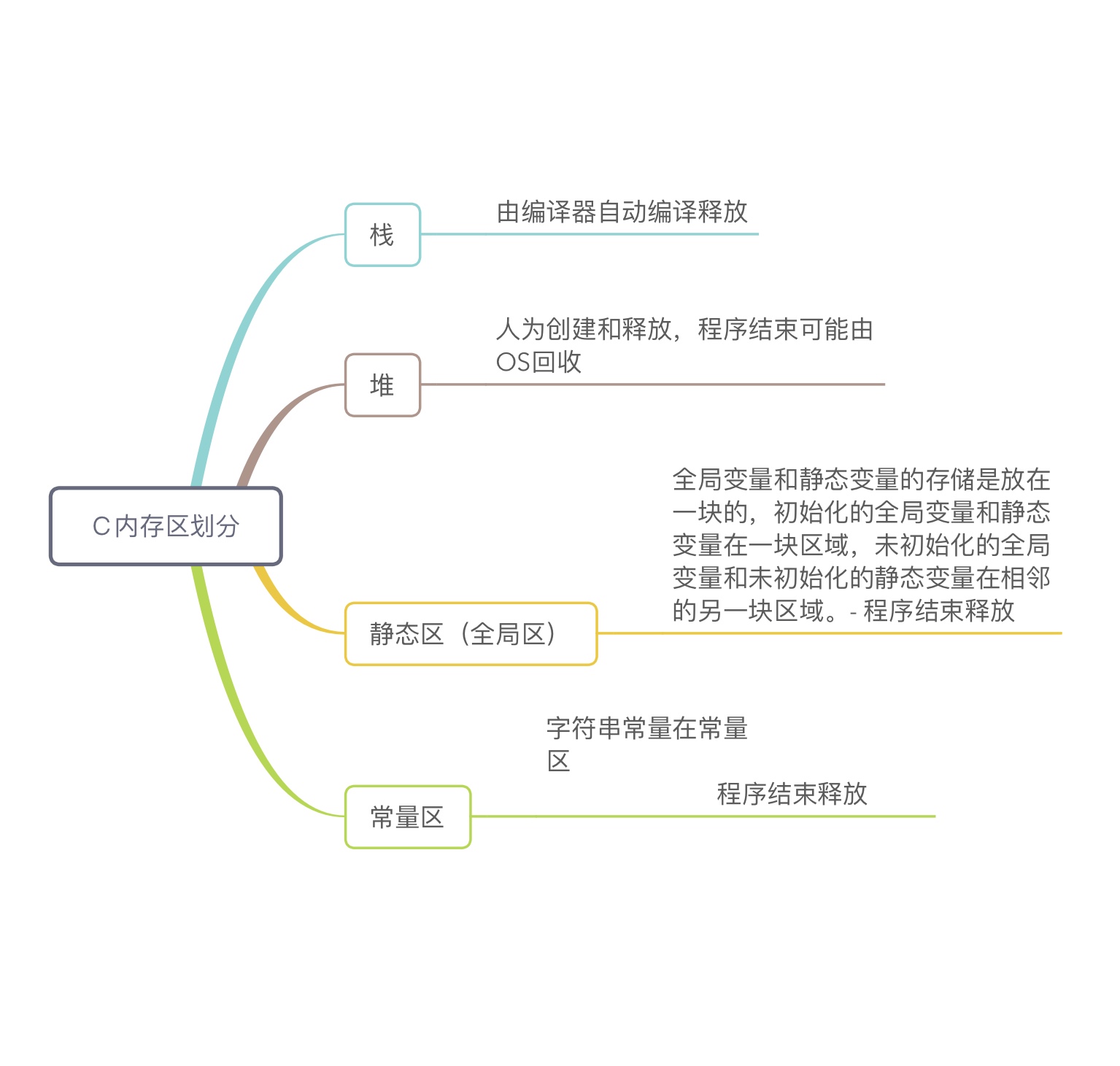
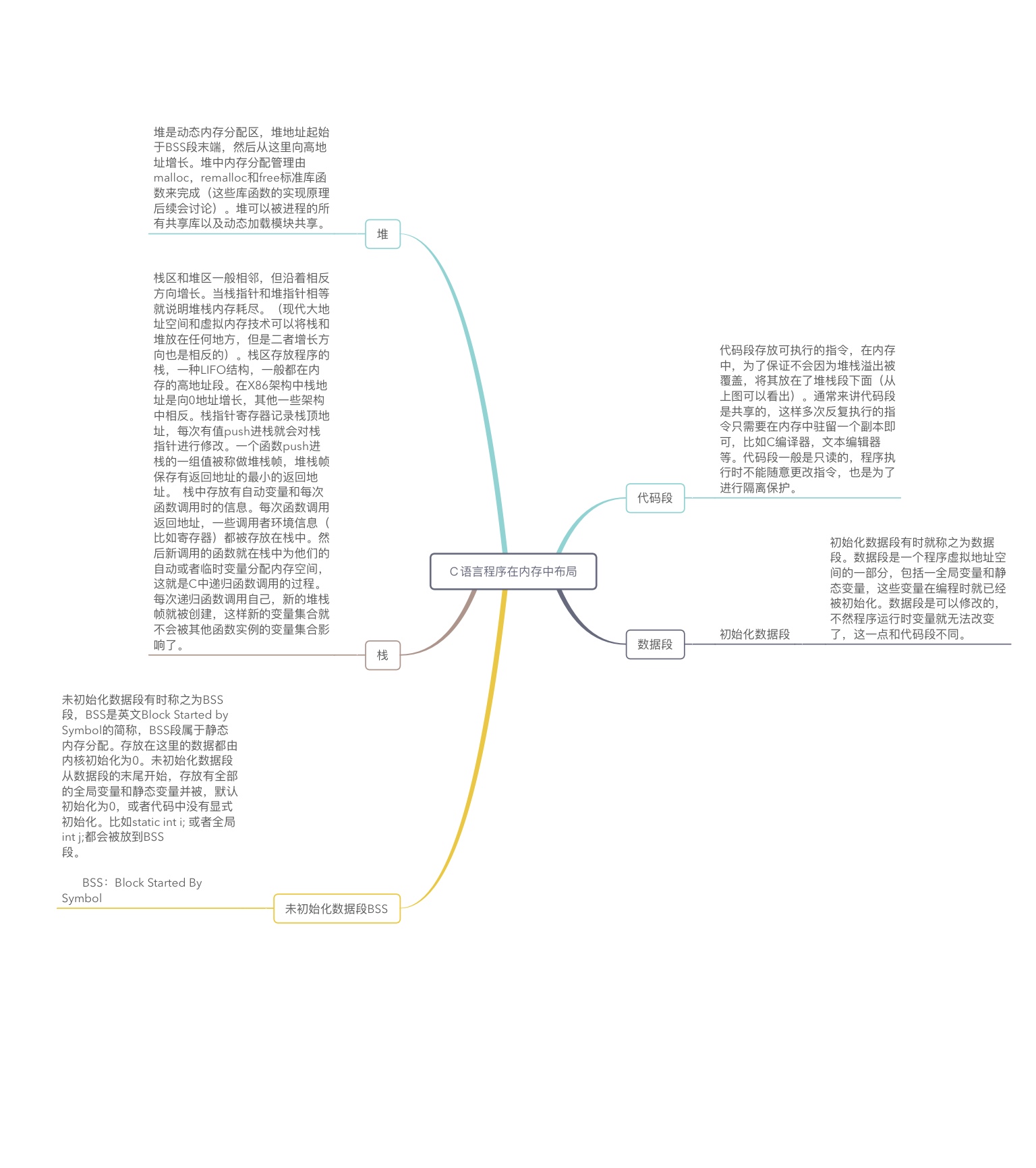
代码如下
我们先来看下面的一段代码和相关问题:
#define _CRT_SECURE_NO_WARNINGS 1
#include<iostream>
#include<string.h>
int globalVar = 1;
static int staticGlobalVar = 1;
void Test()
{
static int staticVar = 1;
int localVar = 1;
int num1[10] = { 1, 2, 3, 4 };
char char2[] = "abcd";
char* pChar3 = "abcd";
int* ptr1 = (int*)malloc(sizeof (int)* 4);
int* ptr2 = (int*)calloc(4, sizeof(int));
int* ptr3 = (int*)realloc(ptr2, sizeof(int)* 4);
free(ptr1);
free(ptr3);
std::cout << "sizeof(num1):" <<sizeof(num1) << std::endl;
std::cout << "sizeof(char2):"<<sizeof(char2) << std::endl;
std::cout << "strlen(char2):" << strlen(char2) << std::endl;
std::cout << "sizeof(pChar3):" << sizeof(pChar3) << std::endl;
std::cout << "strlen(pChar4):" << strlen(pChar3) << std::endl;
std::cout << "sizeof(ptr1):" << sizeof(ptr1) << std::endl;
}
int main()
{
Test();
return 0;
}
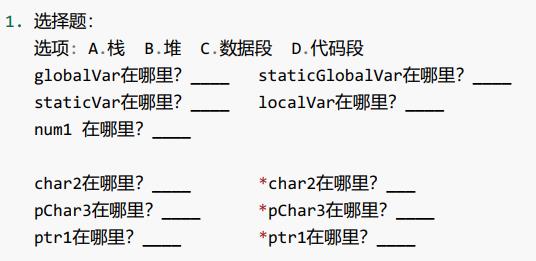
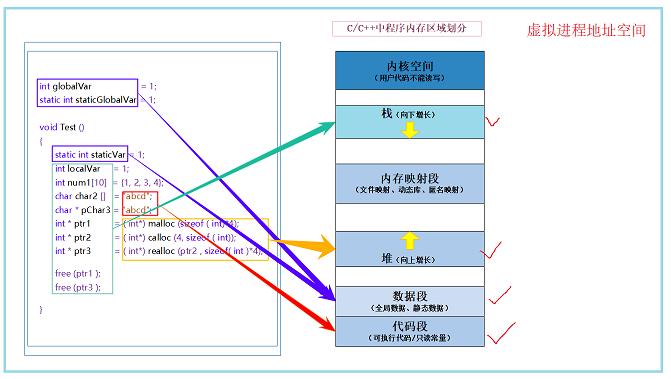
记住: sizeof是一个C语言中的一个单目运算符,而strlen是一个函数,用来计算字符串的长度。sizeof求的是数据类型所占空间的大小,而strlen是求字符串的长度,strlen(结束的标志是是否碰到\\0)。


- 说明:
- 栈又叫堆栈,非静态局部变量/函数参数/返回值等等,栈是向下增长的。
- 内存映射段是高效的I/O映射方式,用于装载一个共享的动态内存库。用户可使用系统接口创建共享共享内存,做进程间通信。(Linux课程如果没学到这块,现在只需要了解一下)。
- 堆用于程序运行时动态内存分配,堆是可以上增长的。
- 数据段–存储全局数据和静态数据。
- 代码段–可执行的代码/只读常量。
解释栈为啥是向下生长,堆是向上生长。
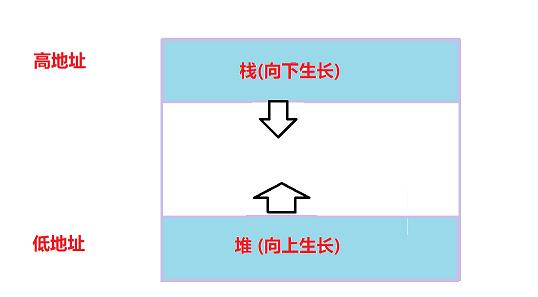
- 栈向下生长是因为在栈区开辟的空间是先开辟的空间在高地址,后开辟的空间在低地址。
代码如下
#define _CRT_SECURE_NO_WARNINGS 1
#include<iostream>
int main()
{
int a = 1;
int b = 2;
std::cout << &a << std::endl;
std::cout << &b << std::endl;
return 0;
}
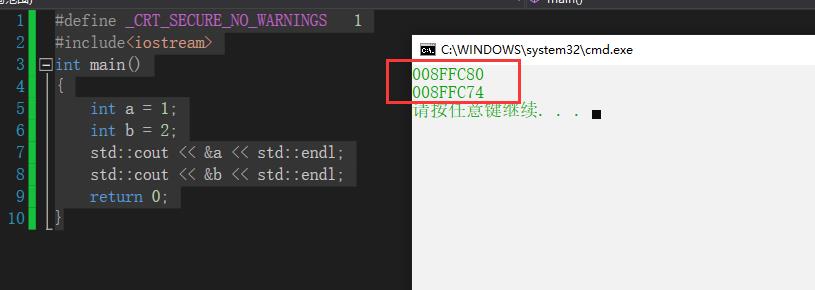
- 堆向上生长是因为在堆区开辟空间先开辟的空间在低地址,后开辟的空间在高地址。
代码如下
int* c = (int*)malloc(sizeof(int));
int* d = (int*)malloc(sizeof(int));
std::cout << c << std::endl;
std::cout << d << std::endl;

注意:在栈区后一个开辟的空间的地址不一定比前面先开辟空间的地址大,因为可能后开辟空间的地址是在前面释放的空间上开辟的地址。
二、C语言中动态内存管理方式
1.malloc/calloc/realloc和free
代码如下
#define _CRT_SECURE_NO_WARNINGS 1
#include<iostream>
// 1.malloc/calloc/realloc的区别是什么
int main()
{
int* p1 = (int*)malloc(sizeof(int));
int* p2 = (int*)calloc(4,sizeof(int));
int* p3 = (int*)realloc(p2, sizeof(int) * 10);
free(p1);
//free(p2); // 这里需要free(p2)吗?
free(p3);
return 0;
}
注意:如果此时你在p2的基础上扩容,则p2则不需要自己释放,否则会发生错误。
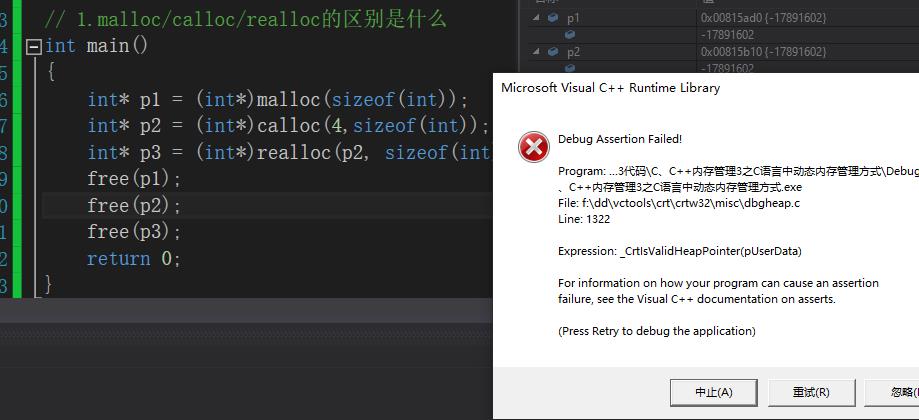
- 【面试题】
malloc/calloc/realloc的区别?

原地扩容:需要扩容的空间后面有充足的空间可以扩容,realloc函数直接在原来的空间后方进行扩容,成功则返回该内存空间首地址(即原来的首地址)。
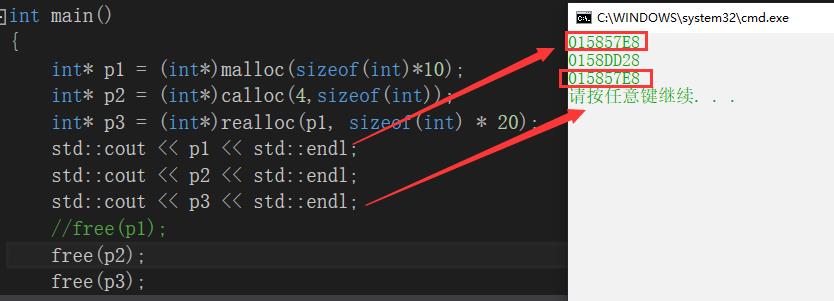
异地扩容:需要扩容的空间后方并没有足够的空间可供扩容,那么,realloc函数会在堆区中再找一块满足大小的内存空间然后将原来空间内的数据拷贝到新空间中,在主动将原空间内存释放(即还给操作系统),不需要自己手动free原有空间,否则会发生错误,最后返回新内存空间的首地址。
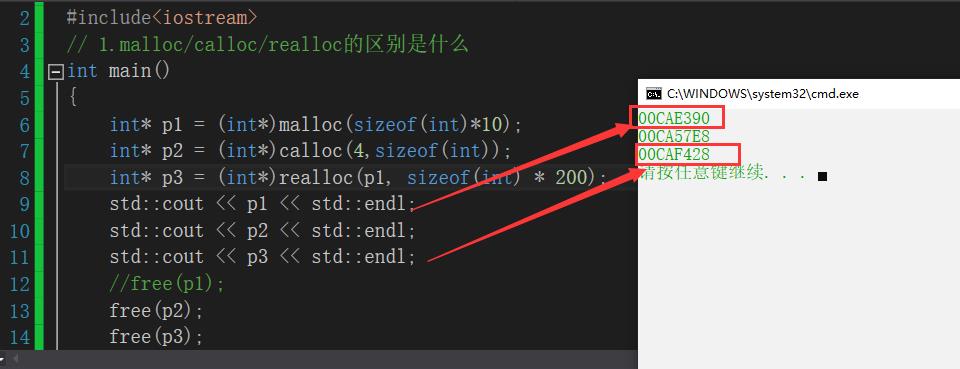
扩容失败:此时堆空间中没有足够的空间来扩容,此时就是扩容失败,返回NULL。
三、C++中动态内存管理
C语言内存管理方式在C++中可以继续使用,但有些地方就无能为力而且使用起来比较麻烦,因此C++又提出了自己的内存管理方式:通过new和delete操作符进行动态内存管理。
1.new/delete操作内置类型
代码如下
#define _CRT_SECURE_NO_WARNINGS 1
#include<iostream>
int main()
{
int* p1 = new int; //C++动态的申请一个int类型的空间
int* p2 = (int*)malloc(sizeof(int*)); //C动态申请一个int类型的空间
delete p1;
free(p2);
int* p3 = new int[10]; //C++动态申请10个int类型的空间
int* p4 = (int*)malloc(sizeof(int*)* 10); //C动态申请1个int类型的空间
delete[] p3;
free(p4);
int* p5 = new int(1); //C++动态申请1个int类型的空间并且初始化为1
int* p6 = new int[3]{1, 2, 3}; //C++动态申请3个int类型的空间并且初始化
delete p5;
delete[] p6;
return 0;
}
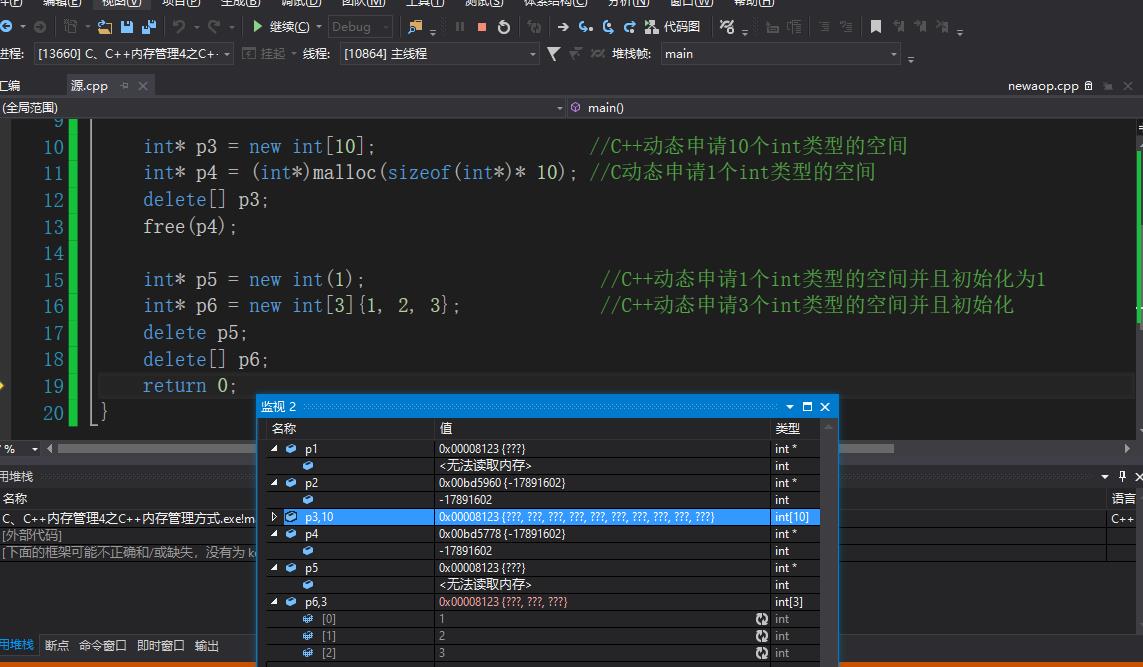
new/delete和malloc/free 针对内置类型没有任何差别,只是用法不一样。
代码如下
void Test()
{
//new/delete和malloc/free 针对内置类型没有任何差别,只是用法不一样
// 动态申请一个int类型的空间
int* ptr4 = new int;
// 动态申请一个int类型的空间并初始化为10
int* ptr5 = new int(10);
// 动态申请10个int类型的空间
int* ptr6 = new int[3];
delete ptr4;
delete ptr5;
delete[] ptr6;
}
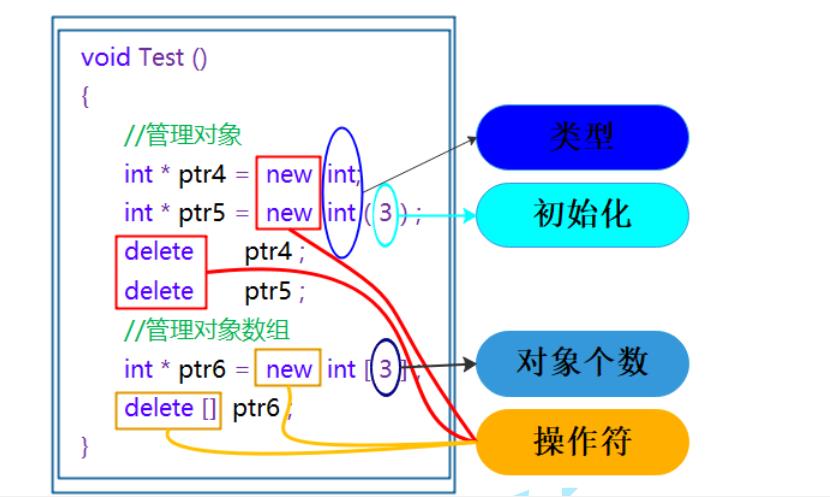
注意:申请和释放单个元素的空间,使用new和delete操作符,申请和释放连续的空间,使用new[]和delete[]。
2.new和delete操作自定义类型
代码如下
#define _CRT_SECURE_NO_WARNINGS 1
#include<iostream>
class Test
{
public:
Test()
:_data(0)
{
std::cout << "Test():" << std::endl;
}
~Test()
{
std::cout << "~Test():" << std::endl;
}
private:
int _data;
};
void Test2()
{
//申请一个Test类型的空间
Test* p1 = (Test*)malloc(sizeof(Test));
free(p1);
//申请十个Test类型的空间
Test* p2 = (Test*)malloc(sizeof(Test)* 10);
free(p2);
}
void Test3()
{
//申请一个Test类型的对象
Test* p1 = new Test;
//申请10个Test类型的对象
Test* p2 = new Test[10];
}
int main()
{
Test T;
Test3();
return 0;
}
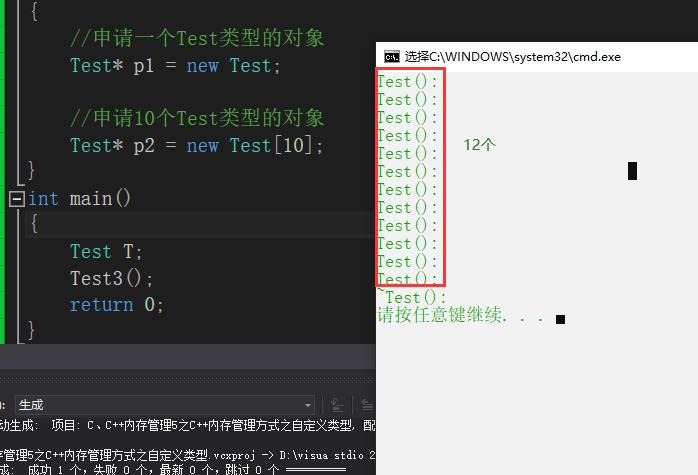
注意:在申请自定义类型的空间时,new会调用构造函数,delete会调用析构函数,而malloc与free不会。
四、operator new与operator delete函数
1.operator new与operator delete函数(重点)
new和delete是用户进行动态内存申请和释放的操作符,operator new 和operator delete是系统提供的全局函数,new在底层调用operator new全局函数来申请空间,delete在底层通过operator delete全局函数来释放空间。
- 实际上 operator new和operator delete的用法跟malloc和free是完全是一样的功能,都是在堆上申请释放空间,但是失败了处理方式不一样,malloc失败返回NULL,operator new失败以后抛异常。
代码如下
#define _CRT_SECURE_NO_WARNINGS 1
#include<iostream>
int main()
{
//以下三种方式开辟空间和释放空间的效果是一样的
int* p1 = (int*)malloc(sizeof(int)); //malloc和free
free(p1);
int* p2 = new int; //new和delete
delete p2;
int* p3 = (int*)operator new(sizeof(int));//operator new与operator delete
operator delete (p3);
return 0;
}
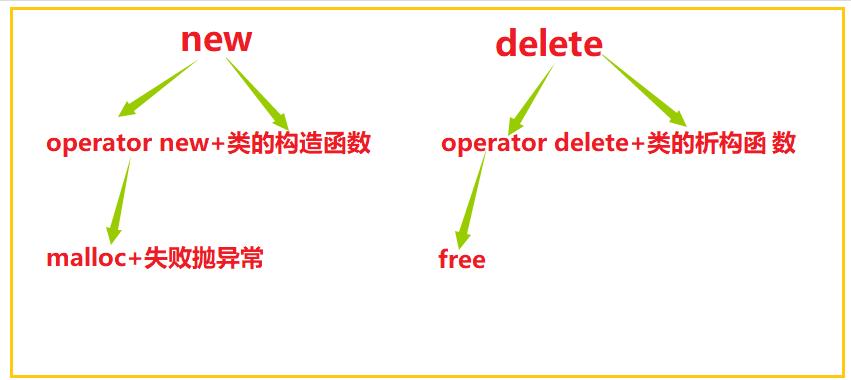
2.operator new失败抛异常机制
operator new失败了处理方式不一样,malloc失败返回NULL,operator new失败以后抛异常。
代码如下
#define _CRT_SECURE_NO_WARNINGS 1
#include<iostream>
using namespace std;
void f()
{
// 他的用法跟malloc和free是完全一样的,功能都是在堆上申请释放空间
// 失败了处理方式不一样,malloc失败返回NULL,operator new失败以后抛异常
void* p3 = malloc(0x7fffffff);
if (p3 == NULL)
{
cout << "malloc fail" << endl;
}
void* p4 = operator new(11);
char* p5 = new char[0x7fffffff];
cout << "继续" << endl;
}
int main()
{
try
{
f();
}
catch (exception& e)
{
cout << e.what() << endl;
}
return 0;
}

operator new与operator delete底层源码
/*
operator new:该函数实际通过malloc来申请空间,当malloc申请空间成功时直接返回;申请空间失败,
尝试执行空 间不足应对措施,如果改应对措施用户设置了,则继续申请,否则抛异常。
*/
void *__CRTDECL operator new(size_t size) _THROW1(_STD bad_alloc)
{
// try to allocate size bytes
void *p;
while ((p = malloc(size)) == 0)
if (_callnewh(size) == 0)
{
// report no memory
// 如果申请内存失败了,这里会抛出bad_alloc 类型异常
static const std::bad_alloc nomem;
_RAISE(nomem);
}
return (p);
}
/*
operator delete: 该函数最终是通过free来释放空间的
*/
void operator delete(void *pUserData)
{
_CrtMemBlockHeader * pHead;
RTCCALLBACK(_RTC_Free_hook, (pUserData, 0));
if (pUserData == NULL)
return;
_mlock(_HEAP_LOCK); /* block other threads */
__TRY
/* get a pointer to memory block header */
pHead = pHdr(pUserData);
/* verify block type */
_ASSERTE(_BLOCK_TYPE_IS_VALID(pHead->nBlockUse));
_free_dbg(pUserData, pHead->nBlockUse);
__FINALLY
_munlock(_HEAP_LOCK); /* release other threads */
__END_TRY_FINALLY
return;
}
/*
free的实现
*/
#define free(p) _free_dbg(p, _NORMAL_BLOCK)
- 通过上述两个全局函数的实现知道,operator new 实际也是通过malloc来申请空间,如果malloc申请空间成功就直接返回,否则执行用户提供的空间不足应对措施,如果用户提供该措施就继续申请,否则就抛异常。operator delete 最终是通过free来释放空间的。
3.operator new与operator delete的类专属重载(了解)
写了类专属重载就不用调用全局的operator new与Operator delete。
struct ListNode
{
ListNode* _next;
ListNode* _prev;
int _val;
//类中重载专属operator new
void* operator new(size_t n)
{
void* p = nullptr;
p = allocator<ListNode>().allocate(1);
cout << "memory pool allocate" << endl;
return p;
}
void operator delete(void* p)
{
allocator<ListNode>().deallocate((ListNode*)p, 1);
cout << "memory pool deallocate" << endl;
}
ListNode(int val)
:_next(nullptr)
, _prev(nullptr)
, _val(val)
{}
};
int main()
{
ListNode* p = new ListNode(1);
delete p;
return 0;
}
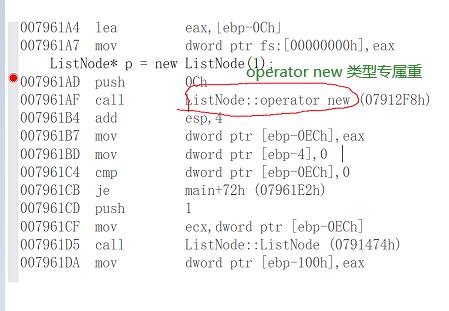
没有写operator new与operator delete。
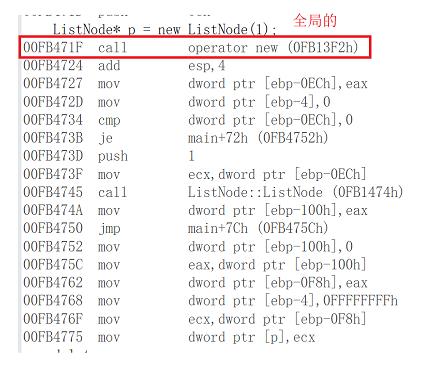
五、new和delete的实现原理
1.内置内型
如果申请的是内置类型的空间,new和malloc,delete和free基本类似,不同的地方是:new/delete申请和释放的是单个元素的空间,new[]和delete[]申请的是连续空间,而且new在申请空间失败时会抛异常,malloc会返回NULL。
2.自定义类型
1.new的原理
- 调用operator new函数申请空间
- 调用operator new函数申请空间
2.delete的原理
- 在空间上执行析构函数,完成对象中资源的清理工作。
- 调用operator delete函数释放对象的空间。
3.new T[N]的原理
- 调用operator new[]函数,在operator new[]中实际调用operator new函数完成N个对象空间的申请。
- 在申请的空间上执行N次构造函数。
4.delete T[N]的原理
- 在释放的对象空间上执行N次析构函数,完成N个对象中资源的清理。
- 调用operator delete[]释放空间,实际在operator delete[]中调用operator delete来释放空间。
六、定位new表达式(placement-new)(了解)
定位new表达式是在已分配的原始内存空间中调用构造函数初始化一个对象。
使用场景:
定位new表达式在实际中一般是配合内存池使用。因为内存池分配出的内存没有初始化,所以如果是自定义类型的对象,需要使用new的定义表达式进行显示调构造函数进行初始化。
代码如下
#define _CRT_SECURE_NO_WARNINGS 1
#include<iostream>
using namespace std;
class A
{
public:
A(int a = 0)
: _a(a)
{
cout << "A():" << this << endl;
}